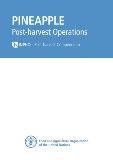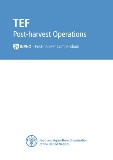Training and capacity building Publications

Garlic: Post-Harvest Operations
21/12/2007
Garlic is a crop widely grown for the fresh local market by many producers on a small scale and by a few large scale producers for both fresh sales and processing. China produced 77 percent of the world’s 15 million tonnes in 2008 (FAOSTAT). There are about 300 varieties of garlic cultivated worldwide and it can be easily grown in most mild climates and stores well for several months under the correct conditions. It has many culinary uses as a flavouring and a range of medicinal benefits.

Pineapple: Post-Harvest Operations
03/11/2005
Pineapple fruit is a member of the Bromiaceae family and grows in tropical and subtropical climates. The fruit is eaten raw, canned or juiced. Pineapple is an important tropical fruit in world trade. Brazil, China, Costa Rica, Indonesia, the Philippines, and Thailand are among the largest producers.

Grape: Post-Harvest Operations
31/03/2005
Grape is one of the most widely utilized fruits in the world, both in its fresh form and processed into raisins, grape juice and wine. These different processed products are important due to the extreme perishability of the fruit. As fresh fruit, grapes are very delicate and the loss at harvest and during the distribution is very high.

Cowpea | Post-harvest operations
15/06/2004
Cowpea is a legume that is extensively grown, particularly throughout sub-Saharan Africa. It is a subsistence crop, often intercropped with sorghum, maize and pearl millet. The peas provide valuable protein, the leaves are used as a nutritious vegetable and the rest of the plant serves for animal feed. The plants are drought tolerant and grow well on relatively poor soils. The peas can be consumed fresh or removed from the pods and dried.

Avocado: Post-Harvest Operations
15/06/2004
Post-harvest handling is critical to Avocado fruit quality; mechanical damage, over chilling and fungal contamination are the most common causes of loss. There is a large world-wide market for predominantly fresh fruit but also for processed foods and cosmetic products.

Yams | Post-harvest operations
28/08/2003
Yams are second to cassava as the most important tropical root crop and are a staple food in many parts of Africa, Southeast Asia and the South Pacific. Seventy percent of the 50 million tonne world output of 2008 was grown in Nigeria (FAOSTAT).The starchy tuber, with a rough brown skin, is produced by a herbaceous vine and takes from 8 to 11 months to mature after planting.

Edible aroids | Post-harvest operations
28/08/2003
Edible aroids are root crops grown widely in tropical and sub-tropical countries. Taro also known as cocoyam and tannia are the more common species. World taro production in 2008 was over 11 million tonnes principally in Cameroon, China, Ghana and Nigeria, with smaller production in other areas of Africa, Asia and South Pacific (FAOSTAT).

Onion: Post-Harvest Operations
28/08/2003
Onion is an important crop worldwide. It is grown in both tropical and temperate regions at all scales of production. Improving post-harvest techniques in small and medium farming can particularly enhance efficiency and quality. If dried and packed properly, the bulbs can be stored and transported for considerable distances without deteriorating.

Soybean: Post-Harvest Operations
06/07/2002
Soybean is a useful oil and protein source and can be used to improve the nutritional value of traditional foods. The beans are processed to give soy flour, meal or milk products and the oil can be extracted leaving a meal which is used for animal feed.

Groundnut | Post-harvest operations
07/06/2002
Groundnut is rich in oil and protein and has a high-energy value. The largest producers are China, India, Nigeria and the United States of America, but many other African and South American countries also have sizeable production. Groundnut provides high-quality cooking oil and is an important source of protein for both human and animal diets.

Mango: Post-Harvest Operations
02/06/2002
Mango is an important fruit for inhabitants of the tropics, with India being the largest producer. The trees require a frost-free tropical or sub-tropical climate, are 10 to 40 m in height and evergreen. The fruit is produced seasonally and eaten fresh or used in various recipes. In recent years, mangoes have become well established as fresh fruit and processed products in the global market.

Potato | Post-harvest operations
17/05/2001
Potato is an important staple food world-wide, claiming fourth place after maize, rice and wheat. It is a good carbohydrate source in addition to other nutritional benefits. Potatoes are cooked before consumption which reduces the presence of the toxic alkaloid solanine. Developing countries now produce approximately one third of world production, which was 314 million tonnes in 2008 (FAOSTAT).

Teff: Post-Harvest Operations
14/05/2001
Teff is a staple crop in Eritrea and Ethiopia where it is a native annual grass species but is not widely known around the world. The very small seeds are cooked or fermented and have good nutritional content. The plant is very adaptable to different conditions but is day length sensitive, requiring 12 hours of daylight to flower.

Turmeric | Post-harvest operations
22/04/2001
Turmeric is a rhizome of a perennial herbaceous plant native to South Asia which requires a tropical climate. Southern India is the world’s largest producer. It can be used fresh or dried and ground to a fine powder. It imparts a distinctive flavour but it is also used to provide food with a deep, orange colour. It is an important ingredient in the curry dishes and cuisine of South Asia.

Wheat: Post-Harvest Operations
14/10/1999
Wheat is widely grown around the world under diverse climatic conditions and has been the staple food of the major civilizations in Europe, Asia and North Africa for 8,000 years. As an important staple food used in a wide variety of products, post-production operations play an important role in creating a stable food supply. Wheat is also used to produce animal feedstuffs, starch and ethanol.

Plantain: Post-Harvest Operations
14/10/1999
Plantain is a staple food and major source of carbohydrates for millions of people in Africa, Asia, the Caribbean, Latin America, and the Pacific. The fruit is predominantly used for human consumption and is generally cooked by boiling or frying when mature (green) or ripened. There is great potential for the crop in improved production methods and post-harvest techniques.

Rice: Post-Harvest Operations
14/10/1999
Rice is a staple food for over half the world's people and has the second largest cereal production after maize with over 685 million tonnes recorded in 2008 (FAOSTAT). China, India, Indonesia and Pakistan are the biggest producers. Rice cultivation requires more water than other cereals and is more labour intensive.

Sorghum: Post-Harvest Operation
14/10/1999
Sorghum is the fifth most important cereal grown with a world production of over 55 million tonnes in 2008 (FAOSTAT). Most varieties are heat and drought tolerant, hence it is an important crop in arid areas. It is an important source of food in Africa, Central America, and South Asia and is also used to produce alcoholic beverages and biofuel.

Coconut | Post-harvest operations
14/10/1999
Coconut, the fruit from the coconut palm tree is widely grown throughout the tropics. The palm trees grow to 30 m and require a continuous frost-free warm climate, plenty of rain and sunlight. India, Indonesia and the Philippines are the largest producers. An adult palm tree will produce coconut fruits every month throughout the year. Young immature coconuts are harvested for coconut water, a nutritious drink, and mature fruits for the white ‘meat’ and oil.

Cassava | Post-harvest operations
14/10/1999
Cassava is an edible root that provides an important source of carbohydrates for an estimated 500 million people in Africa, Asia and the Americas. World production was 230 million tonnes in 2008, with Nigeria as the largest producer followed by Brazil, Thailand and Indonesia (FAOSTAT).
